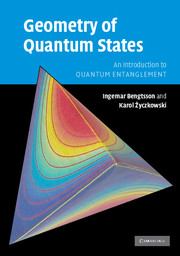Book contents
- Frontmatter
- Contents
- Preface
- 1 Convexity, colours and statistics
- 2 Geometry of probability distributions
- 3 Much ado about spheres
- 4 Complex projective spaces
- 5 Outline of quantum mechanics
- 6 Coherent states and group actions
- 7 The stellar representation
- 8 The space of density matrices
- 9 Purification of mixed quantum states
- 10 Quantum operations
- 11 Duality: maps versus states
- 12 Density matrices and entropies
- 13 Distinguishability measures
- 14 Monotone metrics and measures
- 15 Quantum entanglement
- Epilogue
- Appendix 1 Basic notions of differential geometry
- Appendix 2 Basic notions of group theory
- Appendix 3 Geometry: do it yourself
- Appendix 4 Hints and answers to the exercises
- References
- Index
Preface
Published online by Cambridge University Press: 27 August 2009
- Frontmatter
- Contents
- Preface
- 1 Convexity, colours and statistics
- 2 Geometry of probability distributions
- 3 Much ado about spheres
- 4 Complex projective spaces
- 5 Outline of quantum mechanics
- 6 Coherent states and group actions
- 7 The stellar representation
- 8 The space of density matrices
- 9 Purification of mixed quantum states
- 10 Quantum operations
- 11 Duality: maps versus states
- 12 Density matrices and entropies
- 13 Distinguishability measures
- 14 Monotone metrics and measures
- 15 Quantum entanglement
- Epilogue
- Appendix 1 Basic notions of differential geometry
- Appendix 2 Basic notions of group theory
- Appendix 3 Geometry: do it yourself
- Appendix 4 Hints and answers to the exercises
- References
- Index
Summary
The geometry of quantum states is a highly interesting subject in itself, but it is also relevant in view of possible applications in the rapidly developing fields of quantum information and quantum computing.
But what is it? In physics words like ‘states’ and ‘system’ are often used. Skipping lightly past the question of what these words mean – it will be made clear by practice – it is natural to ask for the properties of the space of all possible states of a given system. The simplest state space occurs in computer science: a ‘bit’ has a space of states that consists simply of two points, representing on and off. In probability theory the state space of a bit is really a line segment, since the bit may be ‘on’ with some probability between zero and one. In general the state spaces used in probability theory are ‘convex hulls’ of a discrete or continuous set of points. The geometry of these simple state spaces is surprisingly subtle – especially since different ways of distinguishing probability distributions give rise to different notions of distance, each with their own distinct operational meaning. There is an old idea saying that a geometry can be understood once it is understood what linear transformations are acting on it, and we will see that this is true here as well.
The state spaces of classical mechanics are – at least from the point of view that we adopt – just instances of the state spaces of classical probability theory, with the added requirement that the sample spaces (whose ‘convex hull’ we study) are large enough, and structured enough, so that the transformations acting on them include canonical transformations generated by Hamiltonian functions.
- Type
- Chapter
- Information
- Geometry of Quantum StatesAn Introduction to Quantum Entanglement, pp. ix - xiiPublisher: Cambridge University PressPrint publication year: 2006



